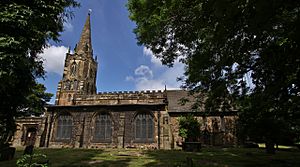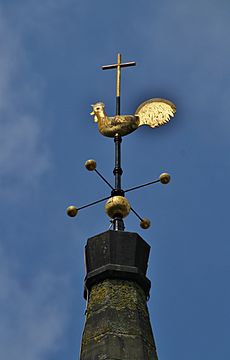St Mary's Church, Handsworth, Sheffield facts for kids
Quick facts for kids Church of St Mary the Virgin, Handsworth |
|
|---|---|

The church from the south
|
|
| Lua error in Module:Location_map at line 420: attempt to index field 'wikibase' (a nil value). | |
| OS grid reference | SK 41050 86204 |
| Location | Handsworth, South Yorkshire |
| Country | England |
| Denomination | Church of England |
| Churchmanship | Anglo-Catholic |
| Website | St Mary the Virgin S13 9BZ |
| History | |
| Status | church |
| Dedication | St Mary the Virgin |
| Architecture | |
| Functional status | active |
| Heritage designation | Grade II listed |
| Designated | 28 June 1973 |
| Style | Gothic, Gothic Revival |
| Years built | 12th to 19th centuries |
| Specifications | |
| Number of spires | 1 |
| Materials | stone |
| Bells | 8 |
| Tenor bell weight | 12 long tons 0 cwt 2 qr (26,940 lb or 12.22 t) |
| Administration | |
| Parish | St Mary the Virgin, Handsworth |
| Diocese | Sheffield |
| Province | York |
St Mary's Church is a historic Church of England church in Handsworth, South Yorkshire. It is located about three and a half miles east of the city center of Sheffield, England. The church has stood for over 850 years and is an important local landmark.
Because of its historical and architectural importance, it is a Grade II listed building. This means it is a nationally important building that is specially protected.
Contents
The Long History of St Mary's Church
St Mary's has changed a lot over the centuries. It started as a Norman church and was rebuilt and repaired many times.
How the Church Began
The first church on this site was built around the year 1170. It was a Norman church, built in a style popular after the Norman conquest of England. A Norman lord named William de Lovetot founded the church.
About 50 years later, in the 1220s, a special chapel was added. It was called St Katherine's Chapel. It was likely built for a noblewoman named Maud de Lovetot. She wanted a place for prayers to be said for her husband and son, who had died. Her son, Thomas de Furnival, died while on a crusade in the Holy Land.
Rebuilding and Repairs
By 1472, records from York showed that the church was in ruins. Thankfully, it was already being rebuilt. During the Tudor period, powerful nobles from the Earl of Shrewsbury's family paid for many repairs.
The church has had bad luck with weather. In 1698, lightning hit the church's tall spire. The new steeple built to replace it was much shorter. People called it "the Handsworth stump."
In the 1820s, the "stump" was torn down and a new, taller tower was built. But in January 1978, lightning struck again! This time, the damage was not as bad. The spire, clock, and bell tower were all repaired in 2002.
Bells of St Mary's
The church's west tower holds a ring of eight bells. All eight bells were remade and re-hung in 1920 by the famous bell-making company John Taylor & Co. There is also an older service bell that was made back in 1590.
Buildings Around the Church
The area around St Mary's has other historic buildings connected to the church's past.
The Old Rectory
A rectory is a house where the church's rector (the main priest) lives. The original rectory was a timber-framed building from the Tudor era. It stood where the Parish Centre is today.
In the late 1600s or early 1700s, a larger, more modern rectory was built next to the church. Parts of the old Tudor building were used in the new one. You can still see a piece of the old wall, made of straw and mud, in the current museum.
The Chantry Inn
Next to the church is a building called the Chantry Inn. It was built in the 1200s as a house for the chaplains (priests) who worked at St Mary's.
After a period of religious change in England called the Reformation, the house was no longer needed for priests. It was turned into a school. Then, around 1804, it became a public house, or pub, which it still is today.
Keeping Track of History
St Mary's has kept detailed records for centuries. The parish registers, which record baptisms, marriages, and funerals, go all the way back to 1558. These records provide a fascinating look into the lives of people in Handsworth over hundreds of years.



